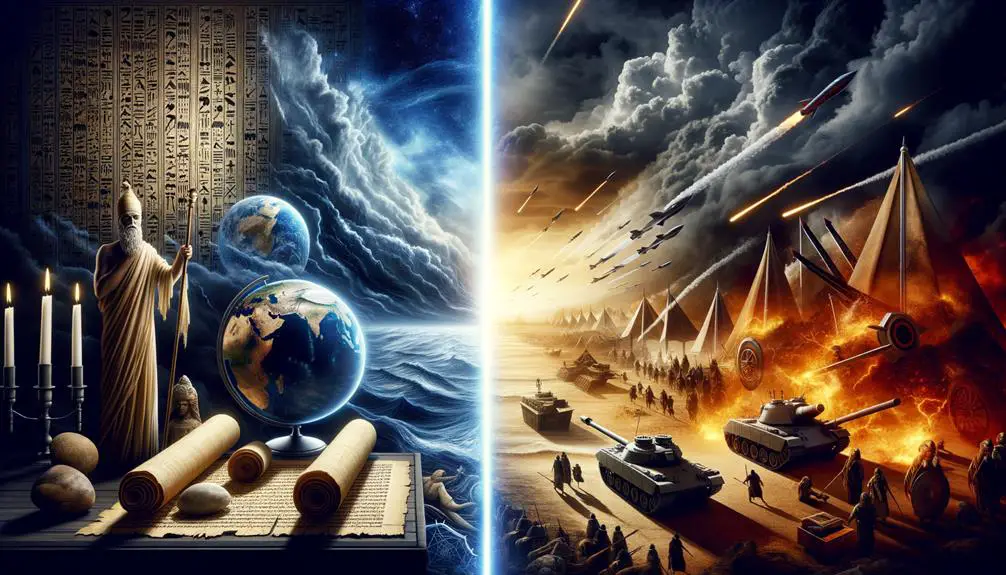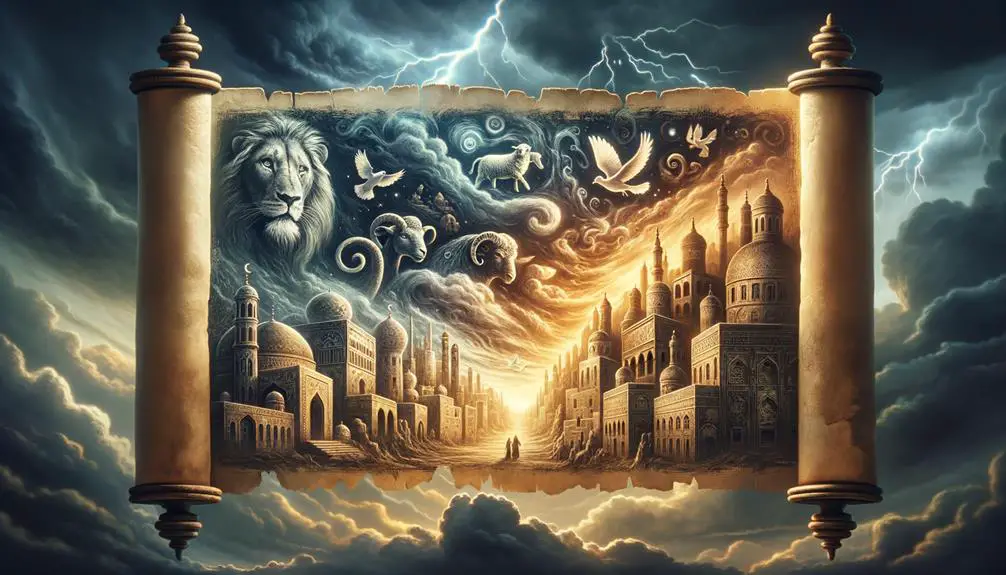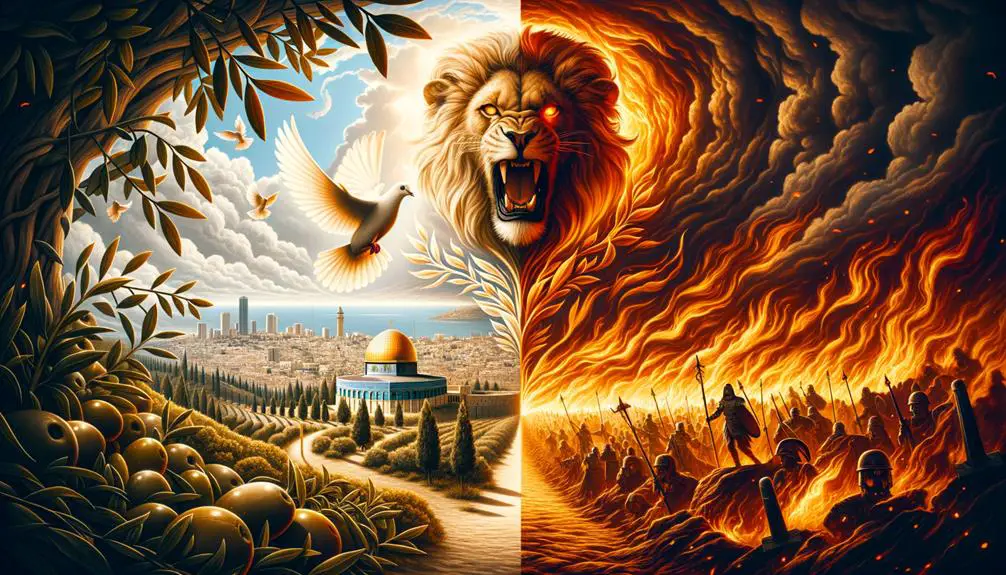Kneel into the mysteries of Biblical prophecies hinting at WW3, and uncover how ancient texts might shape our understanding of future conflicts.

Ww3 in the Bible
Did you know that over 30% of the Bible is composed of prophetic literature, much of which has been interpreted by scholars and enthusiasts as pointing towards future global conflicts, including what some call World War 3?
You're likely familiar with the vivid imagery of the Book of Revelation or Daniel's cryptic visions, but understanding how these ancient texts might relate to modern geopolitics and potential future wars requires a nuanced approach.
As we explore these prophetic scriptures, you'll discover intriguing interpretations that connect ancient predictions with today's world events, leaving you to ponder the profound implications for our future.
Key Takeaways
- Biblical prophecies, rich in symbolism, often hint at large-scale conflicts relevant to modern geopolitical landscapes.
- Interpretation of prophecies like those in Daniel and Ezekiel requires understanding their historical and cultural contexts.
- Symbols in prophecies, such as beasts and statues, may represent empires and conflicts potentially analogous to a "WW3" scenario.
- Israel's significant role in biblical prophecies suggests its central place in understanding future global geopolitical events.
Biblical Prophecies Interpreted

Throughout history, scholars and theologians have interpreted numerous biblical prophecies as potential indicators of world conflicts, including what some speculate could be World War III. You're entering a realm where ancient contexts and cultural influences play pivotal roles in understanding these interpretations. The ancient texts of the Bible were written in times vastly different from our own, with specific cultural, political, and social dynamics that shaped their narratives and messages.
Analyzing these prophecies requires a deep dive into the ancient contexts in which they were penned. The prophets of old, such as Isaiah, Daniel, and Ezekiel, communicated their visions within the framework of their contemporary world events, often using symbolic language deeply embedded in their own cultural references. These references, while clear to their original audiences, may seem cryptic or ambiguous to modern readers without a thorough understanding of ancient Near Eastern cultures.
Cultural influences are also crucial in interpreting these prophecies. The symbolism used in biblical texts often draws from common motifs and themes of the time, such as conquests, natural disasters, and divine interventions, which were understood as signs or omens. Understanding these cultural influences helps in deciphering the intended messages behind the prophecies and how they were perceived by their original audience.
The Book of Revelation Explained
You'll find that the Book of Revelation, rich in symbols, sets the stage for interpreting prophetic timelines critical to understanding potential world-ending events. Challenges in interpretation arise due to its symbolic language and the historical context in which it was written.
These elements collectively make decoding its messages regarding WW3 a complex but fascinating endeavor.
Symbols in Revelation
The Book of Revelation is replete with symbols that serve as metaphors for deeper theological truths and eschatological events. You'll encounter heavenly creatures and apocalyptic horsemen, each embodying complex concepts within Christian eschatology. These symbols aren't meant to be understood literally; rather, they invite you to delve into the spiritual significance they hold.
The four horsemen, for instance, represent conquest, war, famine, and death, portraying the trials humanity faces before the end times. Similarly, heavenly creatures, such as the four living beings surrounding God's throne, symbolize attributes of God—omnipotence, wisdom, justice, and sovereignty.
Analyzing these symbols requires a discerning eye, as they're woven intricately into the narrative to reveal the multifaceted nature of divine prophecy and judgment.
Prophetic Timelines Unveiled
Having explored the rich tapestry of symbols in Revelation, we now turn our focus to the prophetic timelines that these symbols illuminate, offering a clearer understanding of eschatological sequences as laid out in this enigmatic book. These timelines are not just chronological; they're deeply embedded in historical context and shaped by cultural interpretations.
Era |
Symbol |
Meaning |
|---|---|---|
Ancient |
Beast |
Political powers |
Medieval |
Dragon |
Satanic influence |
Modern |
Lamb |
Divine intervention |
This table encapsulates how symbols transcend their literal depiction, representing evolving concepts through ages. It's crucial to dissect these symbols within their respective historical and cultural frameworks to grasp their full significance. This approach allows for a more nuanced understanding of Revelation's prophetic timelines, bridging ancient prophecies with contemporary relevance.
Interpretation Challenges
Deciphering the Book of Revelation poses numerous challenges, as its rich symbolic language requires a deep understanding of historical, cultural, and theological contexts. You're confronted with a text that's not only ancient but also wrapped in a tapestry of apocalyptic imagery, making it difficult to distinguish literal from metaphorical elements.
Delving into its historical context reveals how the socio-political climate of the era influenced its writing. Cultural influences, too, play a pivotal role; the symbolism used might've carried specific meanings for contemporary readers, which are lost or transformed over centuries. This complexity necessitates a multi-faceted approach to interpretation, combining scholarly rigor with an openness to the text's multifarious layers, ensuring you don't oversimplify or misinterpret its profound messages.
Daniel's Visions and Modern Times
You must consider the interpretations of Daniel's visions as they present a complex framework for understanding historical and eschatological narratives.
Analyzing modern events through the lens of these prophecies allows for a nuanced exploration of their relevance to contemporary geopolitical shifts.
Lastly, the end times significance attributed to Daniel's visions invites a critical examination of their implications for modern theological discourse.
Interpretations of Daniel's Visions
Interpreting Daniel's visions, scholars link these ancient prophecies to modern times, suggesting they may foreshadow global events that resemble scenarios of world conflict. This perspective draws heavily on angel interpretations and questions of vision authenticity, urging a careful examination of these biblical texts.
Scholars analyze the visions using a nuanced approach that considers:
- The historical and cultural context of Daniel's time.
- The symbolic language used and its potential modern parallels.
- The role of angelic beings in conveying these visions.
- The criteria used to evaluate the authenticity and relevance of these prophecies today.
This analysis provides a foundation for understanding how ancient prophecies might resonate with contemporary global challenges, while maintaining a critical stance on their interpretation and application.
Modern Events and Prophecy
In examining Daniel's visions, we find that their implications for modern events invite a complex analysis of how ancient prophecies may parallel current global challenges.
You're delving into a realm where the lines between historical accuracy and geopolitical implications blur. Daniel's prophetic imagery, once confined to the ancient world, now sparks debates on its relevance to today's international dynamics.
Scholars argue that understanding these visions requires a nuanced grasp of both historical contexts and contemporary geopolitical landscapes. It's not just about predicting the future; it's about comprehensively analyzing how past prophecies resonate with current affairs.
This approach doesn't simplify the narrative but enriches your understanding of how ancient texts might reflect on today's complex geopolitical stage.
End Times Significance
Building on the understanding of Daniel's visions, it's crucial to explore their significance for the concept of end times in relation to modern times. These visions, steeped in historical accuracy, offer profound moral implications for today's society.
Consider the following imagery:
- The Great Statue: Symbolizing empires' rise and fall, reflecting the transient nature of human power.
- The Four Beasts: Representing kingdoms, emphasizing the moral decay and eventual divine judgment.
- The Ram and the Goat: Illustrating specific historical conflicts, underscoring the precision of prophetic fulfillment.
- The Seventy Weeks: Pointing to Messianic expectations, highlighting the intertwined destinies of humanity and divine purpose.
Through these symbols, you're invited to reflect on the eternal struggle between good and evil, discerning the moral lessons for our times.
Ezekiel's Predictions Revisited
Ezekiel's prophecies, often revisited by scholars, offer a complex view of future events that many have linked to the concept of a third world war. At the heart of these discussions, you'll find the enigmatic battle of Gog and Magog. This battle, as depicted by Ezekiel, involves ancient alliances that seem to transcend time, hinting at a large-scale conflict involving nations from the north descending upon Israel.
The entities of Gog and Magog, though shrouded in mystery, are thought by some to symbolize a coalition of nations against a divine community. This interpretation suggests a scenario where geopolitical tensions escalate into a global confrontation, mirroring the fears and speculations surrounding the idea of a worldwide conflict. The text's depiction of ancient alliances, revived in a modern context, serves as a poignant reminder of the cyclical nature of history and warfare.
Furthermore, Ezekiel's detailed portrayal of this impending conflict forces you to consider the role of prophecy in understanding future geopolitical landscapes. It's essential to approach these texts with a critical eye, recognizing the symbolic language and allegorical elements used by the prophet. While some argue that these prophecies are allegorical, others see them as literal predictions of future events.
In analyzing Ezekiel's predictions, it's crucial to navigate the fine line between literal interpretation and metaphorical understanding. The discussion of Gog and Magog, coupled with ancient alliances, provides fertile ground for scholarly debate, offering insights into the potential for conflict and the nature of prophetic literature in framing our understanding of possible future events.
The Role of Israel in End-Times

Exploring the role of Israel in end-times prophecies reveals its central position in the unfolding of these biblical narratives, especially in the context of potential global conflicts. The biblical texts, interpreted by scholars and theologians, often place Israel at the heart of eschatological scenarios, symbolizing both the epicenter of divine action and a catalyst for broader geopolitical events. This scrutiny unpacks Israel's pivotal role, with a specific focus on peace negotiations and Jerusalem's significance, shaping the contours of end-times discussions.
- Peace Negotiations: In the tapestry of end-times prophecy, peace negotiations involving Israel are frequently highlighted as precursors to broader eschatological events. These negotiations, often fraught with complexity, are seen as both a fulfillment of prophecy and a trigger for subsequent developments.
- Jerusalem's Significance: The city's spiritual and historical importance transcends religious boundaries, making it a focal point in end-times narratives. Jerusalem embodies a convergence of faith, prophecy, and conflict, underscoring its unparalleled role in biblical eschatology.
- Prophetic Fulfillments: Israel's modern-day geopolitical maneuvers and conflicts are scrutinized through the lens of biblical prophecy, with many interpreting these events as aligning with scriptural predictions regarding the end-times.
- Global Spotlight: The nation's strategic positioning and actions on the world stage keep it at the center of international attention, reinforcing its significance in the context of potential global conflicts and the fulfillment of prophecy.
Analyzing Israel's role in these narratives demands a nuanced understanding of both ancient texts and contemporary geopolitical dynamics, highlighting the intricate interplay between faith, prophecy, and global politics.
Interpreting Signs and Symbols
Frequently, interpreting the myriad signs and symbols found in biblical prophecies requires a discerning eye to uncover their deeper meanings and implications for end-times scenarios. You must grasp the ancient metaphors and understand the cultural context within which these prophecies were written to accurately decipher their messages. This process is akin to translating a complex, ancient language into a modern dialect comprehensible to today's readers.
Consider the following table, which outlines some common symbols found in biblical prophecies, their possible meanings, and the cultural context that informs these interpretations:
Symbol |
Possible Meaning |
Cultural Context |
|---|---|---|
Beast |
Empire or kingdom |
Ancient Near Eastern symbolism of power and dominion |
Waters |
Peoples or nations |
In ancient times, waters often symbolized chaos, and in a political sense, masses of people or nations |
Dragon |
Satan or evil power |
Dragons were emblematic of chaos and evil in ancient mythologies, adopted into biblical texts to represent Satan |
Woman |
Israel or the church |
Depending on the context, a woman in prophecy can symbolize purity and covenant (Israel) or the collective faithful (church) |
Frequently Asked Questions
How Do Different Christian Denominations Interpret the Concept of World War 3 in the Context of Biblical Prophecies?
Different Christian denominations show interpretive diversity when it comes to biblical prophecies and potential global conflicts.
You'll find that some view eschatological symbolism as indicative of literal events, including wars, while others see these symbols as metaphors for spiritual battles or historical events.
This range of interpretations stems from varying doctrinal foundations and scriptural understandings, making the concept of a world-ending conflict subject to broad theological debate among believers.
Are There Any Biblical Prophecies That Skeptics Argue Have Failed, and How Do Proponents of WW3 Interpretations Respond to These Criticisms?
You're exploring if any biblical prophecies have been deemed failures by skeptics, focusing on historical accuracy and interpretation methods. Skeptics often point out prophecies they consider unfulfilled, challenging their validity.
Proponents counter by emphasizing the complexity of interpreting ancient texts, suggesting that misunderstandings or misinterpretations by skeptics are to blame. They argue that prophecies require a nuanced understanding of historical context and symbolic language, defending the credibility of their interpretations.
How Do Interpretations of WW3 in the Bible Impact Contemporary Political and Social Movements?
You're navigating a landscape where symbols shape perceptions. Interpretations of global conflicts as prophetic events weave through cultural influences, molding societal attitudes and actions.
The psychological impact is profound, altering how communities view both current events and future possibilities. As these interpretations gain traction, they don't just reflect but actively shape contemporary political and social movements.
Analyzing this phenomenon reveals the deep interplay between belief systems and global dynamics.
What Role Do Non-Abrahamic Religions' Eschatological Views Play in the Broader Discussion of End-Times and Global Conflict Predictions?
You're exploring how non-Abrahamic religions contribute to global conflict predictions, focusing on eschatological views. Hinduism's Kalki avatar and Buddhism's Maitreya figure prominently, offering unique perspectives on end-times narratives.
These beliefs influence followers' views on contemporary issues, weaving a rich tapestry of interpretations across cultures. Analyzing these figures helps understand the broader discourse on global peace and conflict, highlighting diverse religious insights into the nature of societal transformation and renewal.
How Do Modern Technological Advancements and Cyber Warfare Fit Into Traditional Interpretations of Warfare Described in Biblical Prophecies?
You're navigating through a digital battlefield where artificial intelligence and quantum computing are the new chariots and swords. In this landscape, traditional interpretations of warfare in biblical prophecies need a rethink.
These modern technologies, invisible yet potent, challenge our understanding of conflicts foretold. They introduce a layer of complexity that demands a deep dive into the nexus of spirituality and science, urging a scholarly analysis beyond the tangible into the realm of the unseen.
Conclusion
As you've journeyed through the labyrinth of biblical prophecies, from the enigmatic visions of Daniel to the apocalyptic revelations of John, it's clear that interpreting these ancient texts in the context of modern times is no simple task.
The role of Israel, the complex symbols, and the unfolding global dynamics all hint at a profound narrative yet to be fully understood. The question isn't if these prophecies will manifest but how and when.
The answers remain shrouded in mystery, inviting further scholarly exploration and debate.



Sign up